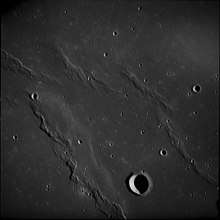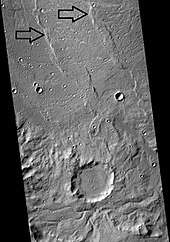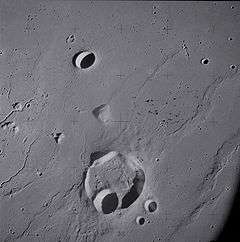Wrinkle ridge

A wrinkle ridge is a type of feature commonly found on lunar maria. These features are low, sinuous ridges formed on the mare surface that can extend for up to several hundred kilometers. Wrinkle ridges are tectonic features created when the basaltic lava cooled and contracted. They frequently outline ring structures buried within the mare, follow circular patterns outlining the mare, or intersect protruding peaks. They are sometimes called veins due to their resemblance to the veins that protrude from beneath the skin. These are found near craters.
Wrinkle ridges are named with the Latin designation dorsum (plural dorsa). The standard IAU nomenclature uses the names of people to identify wrinkle ridges on the Moon. Thus the Dorsa Burnet are named for Thomas Burnet, and the Dorsum Owen is named after George Owen of Henllys.

 Wrinkle ridges in Hesperia Planum, Mars, as seen by Viking The wrinkle ridges go in different directions so compressional forces may have changed direction over time.
Wrinkle ridges in Hesperia Planum, Mars, as seen by Viking The wrinkle ridges go in different directions so compressional forces may have changed direction over time.
 Trough cutting a wrinkle ridge, as seen by HiRISE under HiWish program Location is the Coprates quadrangle, Mars.
Trough cutting a wrinkle ridge, as seen by HiRISE under HiWish program Location is the Coprates quadrangle, Mars.
Wrinkle ridges can also be found on Mars, for example in Chryse Planitia, as well as on several of the asteroids that have been visited by spacecraft, as well as Mercury, and a couple of moons of Jupiter and Saturn. Although several hypotheses have been advanced as causes of Martian wrinkle ridges, today they are generally considered to be of tectonic origin. They involve folding and faulting.[1] They are evidence of compressional stresses in Mars’ crust. The stress created a crack (fault) where one side was pushed on top of the other side, also known as a thrust fault.[2]
See also
References
| Wikimedia Commons has media related to Wrinkle ridges. |
- ↑ Kieffer, H, B. Jakosky, C. Snyder, M. Matthews (eds.). 1992. Mars. University of Arizona Press.
- ↑ http://www.uahirise.org/ESP_046817_1775
Notes
- Golombek, M. P., F. S. Anderson, and M. T. Zuber (2001), Martian wrinkle ridge topography: Evidence for subsurface faults from MOLA, J. Geophys. Res., 106, 23,811–23,821, doi:10.1029/2000JE001308.
- Montési, L. G. J., and M. T. Zuber (2003), Clues to the lithospheric structure of Mars from wrinkle ridge sets and localization instability, J. Geophys. Res., 108(E6), 5048, doi:10.1029/2002JE001974.
- Watters, T. R. (1988), Wrinkle Ridge Assemblages on the Terrestrial Planets, J. Geophys. Res., 93(B9), 10,236–10,254, doi:10.1029/JB093iB09p10236.
- Watters, et al., Evidence of Recent Thrust Faulting on the Moon Revealed by the Lunar Reconnaissance Orbiter Camera. Science 20 August 2010: 936-940. doi:10.1126/science.1189590
